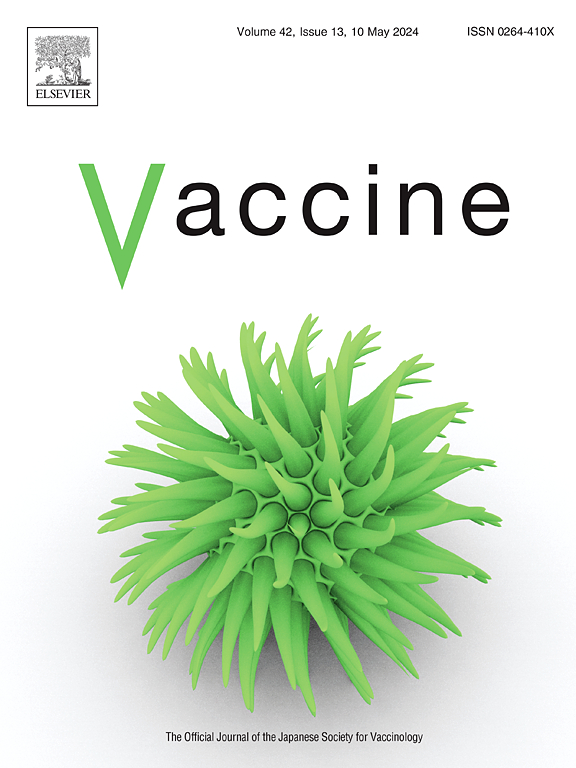Vaccination versus antibody screening for measles immunity in health care workers
IF 4.5
3区 医学
Q2 IMMUNOLOGY
引用次数: 0
Abstract
Aim
To promote measles protection in community and health care facilities a law (Measles Protection act, MPA) came into force in Germany requiring documentation of two measles vaccinations or evidence of measles seropositivity for healthcare workers (HCW) born after 1970. The German Standing Committee on Vaccination extended this law to a recommendation of two measles, mumps, rubella (MMR) vaccinations.
Our aim was to evaluate serology-based vaccination strategies for measles and to consider their extension to mumps and rubella.
Subject and methods
Between 11/2020–7/2021, MMR serostatus was assessed in 386 HCW attending the Occupational Health Service Department for pre-employment or regular occupational examinations. Sociodemographic and documented vaccination data were collected.
Results
Overall, measles IgG seropositivity was 72 %. Measles IgG was found in 77 %, 74 % and 61 % of employees with no, one and two documented measles vaccinations, respectively (p < 0.05). Seropositivity against MMR was detected in 66 % and 58 % with no and one documented measles vaccination, respectively. Considering measles immunity only anti-measles IgG screening prior vaccination saved costs. However, considering MMR seropositivity screening prior vaccination was not cost-effective. Measurement of measles virus neutralizing potency using a quantitative focus reduction neutralization assay to measure measles virus neutralizing potency indicated immunity in persons with two documented measles vaccine doses but negative or equivocal ELISA IgG results.
Conclusion
Measles seropositivity was below 75 % among HCW. In individuals with documentation of two measles vaccine doses ELISA tests underestimate protection, thus no serological testing is needed. Considering measles seropositivity in HCW with no or one documented measles vaccination, measles serological screening before vaccination was most cost-effective. However, aiming at MMR immunity, vaccination of HCW without serological screening was most cost-effective and offers important benefits that should not be dismissed.
卫生保健工作者麻疹免疫接种与抗体筛查
目的:为了促进社区和卫生保健机构的麻疹保护,一项法律(麻疹保护法,MPA)在德国生效,要求1970年以后出生的卫生保健工作者(HCW)提供两次麻疹疫苗接种文件或麻疹血清阳性证据。德国疫苗接种常设委员会将该法扩展为麻疹、腮腺炎、风疹(MMR)两种疫苗接种的建议。我们的目的是评估基于血清学的麻疹疫苗接种策略,并考虑将其推广到腮腺炎和风疹。对象与方法在2020年11月至2021年7月期间,对386名参加职业卫生服务部职前或定期职业检查的HCW进行MMR血清状态评估。收集了社会人口学和记录在案的疫苗接种数据。结果麻疹IgG血清阳性率为72%。在未接种麻疹疫苗、一次接种麻疹疫苗和两次接种麻疹疫苗的员工中,分别有77%、74%和61%的人检测出麻疹IgG (p < 0.05)。在没有接种麻疹疫苗和一次记录接种麻疹疫苗的人群中,分别有66%和58%的人检测到MMR血清阳性。考虑到麻疹免疫,接种前仅进行抗麻疹IgG筛查可节省费用。然而,在疫苗接种前考虑MMR血清阳性筛查并不具有成本效益。采用定量减焦中和法测量麻疹病毒中和效力表明,接种两次麻疹疫苗但ELISA IgG结果阴性或模棱两可的人具有免疫力。结论麻疹血清阳性率低于75%。在有两次麻疹疫苗剂量记录的个体中,ELISA试验低估了保护作用,因此不需要血清学试验。考虑到没有或有一次麻疹疫苗接种记录的HCW的麻疹血清学阳性,疫苗接种前的麻疹血清学筛查是最具成本效益的。然而,针对MMR免疫,不进行血清学筛查的HCW疫苗接种最具成本效益,并提供不应忽视的重要益处。
本文章由计算机程序翻译,如有差异,请以英文原文为准。
求助全文
约1分钟内获得全文
求助全文
来源期刊

Vaccine
医学-免疫学
CiteScore
8.70
自引率
5.50%
发文量
992
审稿时长
131 days
期刊介绍:
Vaccine is unique in publishing the highest quality science across all disciplines relevant to the field of vaccinology - all original article submissions across basic and clinical research, vaccine manufacturing, history, public policy, behavioral science and ethics, social sciences, safety, and many other related areas are welcomed. The submission categories as given in the Guide for Authors indicate where we receive the most papers. Papers outside these major areas are also welcome and authors are encouraged to contact us with specific questions.
 求助内容:
求助内容: 应助结果提醒方式:
应助结果提醒方式:


